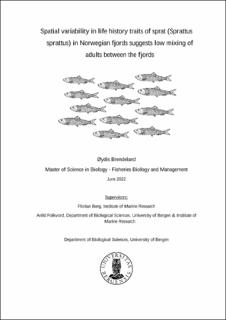| dc.description.abstract | Recent studies have shown almost no genetic variability of sprat (Sprattus sprattus) among Norwegian fjords. However, each fjord creates its own unique habitat, and local adaptations can thereby be expected. An annual coastal sprat cruise has been conducted between 1996-2021 by the Institute of Marine Research with the purpose of monitoring sprat in Nordfjord, Sognefjord, and Hardangerfjord. Investigation of the routinely sampled life history parameters are a cost-effective method supplementing genetic studies to gain insight into the potential population structure of sprat in the fjords. Life history traits are a phenotypic result of genotype and environmental factors. Therefore, it was attempted to consider the influential environmental factor temperature and determine the effect of density-dependence on growth. Differences in life history traits between the fjords, specifically, in growth, length-at-age, length-at-maturity and condition were found. Most prominent results were found for lengthsat-age. The impact of temperature and effect of density-dependence on length of sprat showed differing results between ages and fjords. Shortest lengths-at-age were found in inner Hardangerfjord and Sognefjord, and an overall temporal decline in lengths-at-age were found in these fjords. Sprat in Sognefjord showed signs of density-dependent growth, while the models showed low goodness of fit in Hardangerfjord. Limited food availability, increasing temperatures, and consequently declining lengths-at-age and condition over time have also been seen in other sprat stocks throughout the species distribution. Nordfjord had an overall temporal increase in lengths-at-age, suggesting that the lower abundance found here is not sufficient to cause density-dependent growth. The differing dynamics of life history traits among the fjords suggest that adult sprat mostly stay within its fjord and that potential mixing resulting in gene flow must then occur during the early life stages. | |
